Six Secrets About Temple Worship
FROM MERGING WITH SIVA, by
SATGURU SIVAYA SUBRAMUNIYASWAMI§
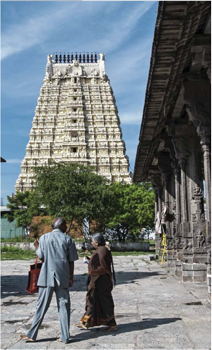
A couple walk barefoot in the precincts of the Sri Ekambaranathar Siva temple in Kanchipuram, Tamil Nadu
• • • • • • • • • • • • • • • • • • • •§
1. One God, Many Gods§
In the Hindu pantheon there are said to be 330 million Gods. Even so, all Hindus believe in one Supreme Being who pervades the entire universe. The many Gods are perceived as divine creations of that one Being. These Gods, or Mahadevas, are real beings, capable of thought and feeling beyond the limited thought and feeling of embodied man. So, Hinduism has one God, but it has many Gods. There are only a few of these Gods for whom temples are built and pujas conducted. Ganesha, Siva, Subramaniam, Vishnu and Shakti are the most prominent Deities in contemporary Hinduism. Of course, there are many others for whom certain rites or mantras are done in daily ceremony, often in the home shrine. These include Brahma, Surya, Sarasvati, Lakshmi, Agni, Chandra, Ayyappan, Hanuman, Mariyamman and others. §
The Hindu traditionally adopts an Ishta Devata. This is a personal Deity chosen from the many Hindu Gods, often according to the devotee’s family background or the feeling of closeness to one form of divine manifestation. It is the unique and all-encompassing nature of Hinduism that one devotee may be worshiping Ganesha while his friend worships Subramaniam or Vishnu, and yet both honor the other’s choice and feel no sense of conflict. The profound understanding and universal acceptance that are unique in Hinduism are reflected in this faculty for accommodating different approaches to the Divine, allowing for different names and forms of God to be worshiped side by side within the temple walls. It may even happen that one may adopt a different personal Deity through the years according to one’s spiritual unfoldment and inner needs. §
2. Temples Are Transformative!§
Visiting a Hindu temple, receiving darshan from the majestic Gods of our religion, can altogether change the life of a worshiper. It alters the flow of the pranas, or life currents, within his body. It draws his awareness into the deeper chakras. It adjusts his beliefs and the attitudes that are the natural consequence of those beliefs. But the change is slow. He lives with the experience for months and months after his visit to the temple. He comes to know and love the Deity. The Deity comes to know and love him, helping and guiding his entire evolutionary pattern. §
Darshan coming from the great temples of our Gods can change the patterns of karma dating back many past lives, clearing and clarifying conditions that were created hundreds of years ago and are but seeds now, waiting to manifest in the future. Through the grace of the Gods, those seeds can be removed if the manifestation in the future would not enhance the evolution of the soul. §
3. Three Worlds Communing§
Hinduism views existence as composed of three worlds. The First World is the physical universe, the Second World is the subtle astral or mental plane of existence in which the devas, or angels, and spirits live, and the Third World is the spiritual sphere of the Mahadevas, the Deities, the Gods. Hinduism is the harmonious working together of these three worlds. Religion blossoms for the Hindu as he awakens to the existence of the Second and Third Worlds. These inner worlds naturally inspire in man responses of love and devotion and even awe. They are that wonderful. §
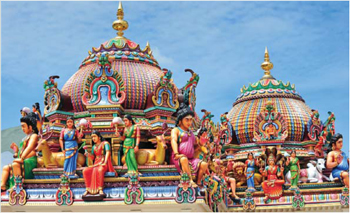
Denizens of the three worlds are often depicted, as here, on a temple’s ornate towers
• • • • • • • • • • • • • • • • • • • •§
It is in the Hindu temple that the three worlds meet and devotees invoke the Gods of our religion. The temple is built as a palace in which the Gods reside. It is the visible home of the Gods, a sacred place unlike every other place on the Earth. The Hindu must associate himself with these Gods in a very sensitive way when he approaches the temple. These intelligent beings have evolved through eons of time and are able to help mankind without themselves having to live in a physical body. These great Mahadevas, with their multitudes of angelic devas, live and work constantly and tirelessly for the people of our religion, protecting and guiding them, opening new doors and closing unused ones. §
The reality of the Mahadevas and their darshan can be experienced by the devotee through his awakened ajna vision, or more often as the physical sight of the image in the sanctum coupled with the inner knowing that He is there within the microcosm. This darshan can be felt by all devotees, becoming stronger and more defined as devotion is perfected. Through this darshan, messages can be channeled along the vibratory emanations that radiate out from the Mahadevas, as well as from their representatives, the Second World devas who carry out their work for them in shrines and altars.§
4. Where Problems Can Be Dissolved§
Hindus always want to live near a temple so they can frequent it regularly. When we go to the temple, we leave with our mind filled with the shakti of the Deity. We are filled and thrilled with the shakti of the temple in every nerve current of our body. When we return to our home, we light an oil lamp, and that brings the power of the temple into the home. This simple act brings the devas in the Second World right into your home, where they can bless the rest of the family who perhaps did not go to the temple. §
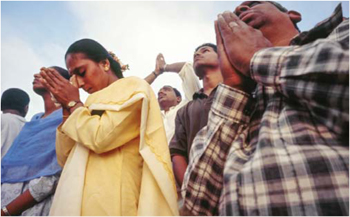
Devotees offer prayers in a temple in Bengaluru, Karnataka
• • • • • • • • • • • • • • • • • • • •§
The devotee stands before the sanctum and telepathically tells the Gods a problem, and with hopeful faith leaves and waits. Days or weeks later, after he had forgotten about his prayer, he suddenly realizes the problem has disappeared. He attempts to trace the source of its solution and finds that a simple, favorable play of circumstance and events brought it about. Had the Gods answered his prayer, or would it have happened anyway? §
He brings another prayer to the Gods, and again in time an answer appears in the natural course of his life. It appears to him that the Gods are hearing and responding to his needs. Trust and love have taken root. He goes on, year after year, bringing the Gods into his secular affairs, while just as carefully the Gods are bringing him into their celestial spheres, enlivening his soul with energy, joy and intelligence. §
The Hindu looks to the Gods for very practical assistance. He devoutly believes that the Gods from their dwelling in the Third World are capable of consciously working with the forces of evolution in the universe and they could then certainly manage a few simpler problems. He devoutly believes that the Gods are given to care for man on the planet and see him through his tenure on Earth, and that their decisions are vast in their implications.§
5. Puja Is Communion§
The physical representation of the God, be it a stone or metal image, a yantra or other sacred form, simply marks the place that the God will manifest in or hover above in His etheric body. It can be conceived as an antenna to receive the divine rays of the God or as the material body in or through which the God manifests in this First World. Man takes one body and then another in his progression through the cycles of birth and death and rebirth. Similarly, the Gods in their subtle bodies inhabit, for brief or protracted spans of time, these temple images. §
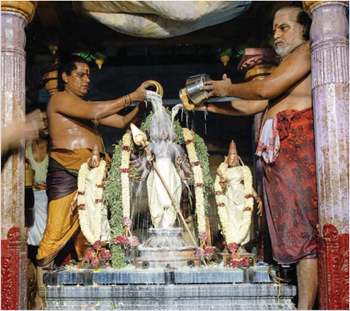
Priests bathe the five-metal parade murti of Lord Shanmukha at the Tirupparankunram Temple near Madurai in Tamil Nadu
• • • • • • • • • • • • • • • • • • • •§
When we perform puja, a religious ritual, we are attracting the attention of the devas and Mahadevas in the inner worlds. That is the purpose of a puja; it is a form of communication. To enhance this communication, we establish an altar in the temple and in the home. This becomes charged or magnetized through our devotional thoughts and feelings, which radiate out and affect the surrounding environment. §
Chanting and satsanga and ceremonial rituals all contribute to this sanctifying process, creating an atmosphere to which the Gods are drawn and in which they can manifest. By the word manifest, I mean they actually come and dwell there and can stay for periods of time, providing the vibration is kept pure and undisturbed. The altar takes on a certain power. In our religion there are altars in temples all over the world inhabited by the devas and the great Gods. When you enter these holy places, you can sense their sanctity. You can feel the presence of these divine beings, and this radiation from them is known as darshan.§
6. Dealing with Disbelief§
In the beginning stages of worship, a Hindu soul may have to wrestle with disbelief in the Gods. He may wonder whether they really exist, especially if his own intuition is obscured by assimilation of Western, existentialist beliefs and attitudes. Yet, he senses their existence, and this sensing brings him back to the temple. He is looking for proof, immersed in the process of coming to know the Gods for himself. He is heartened and assured by hundreds of saints and rishis who have fathomed and found close and enduring relationships with the Gods, and who then extolled their greatness in pages of scripture and chronicle. §
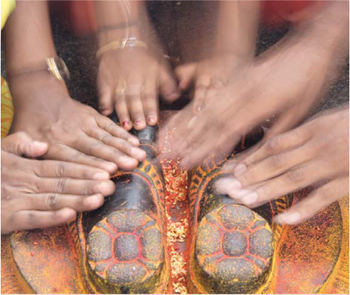
Seeking blessings, pilgrims reverently touch the sculpted stone feet of Lord Vishnu in Tirumala Temple’s Srivari Padalu shrine
• • • • • • • • • • • • • • • • • • • •§
The Gods of Hinduism create, preserve and protect mankind. Their overview spans time itself, and yet their detailed focus upon the complicated fabric of human affairs is just as awesome. It is through their sanction that all things continue, and through their will that they cease. It is through their grace that all good things happen, and all things that happen are for the good. Now, you may wonder why one would put himself under this divine authority so willingly, thus losing his semblance of freedom. But does one not willingly put himself in total harmony with those whom he loves? Of course he does. And loving these great souls comes so naturally. Their timeless wisdom, their vast intelligence, their thoroughly benign natures, their ceaseless concern for the problems and well-being of devotees, and their power and sheer godly brilliance—all these inspire our love.§
 Other Temple Events§
Other Temple Events§
Have faith in God. Believe in Him with all your heart. Think that in the world He is for you the sweetest of all sweet things. Think that there is nothing other than God. Sitting or standing, walking or lying down, think of Him. Let the thought of Him permeate your nerves, flesh and blood. §
Natchintanai 7, Satguru Yogaswami of Jaffna§
Annual Festivals§
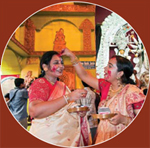 Many annual festivals are celebrated in temples. These are auspicious days when the veil between the worlds is thin and God and the Gods can touch our world. Festivals provide the opportunity to go on pilgrimage, journeying to a far-off temple for blessings and renewal. Celebrated with unmatched fervor but with paced regularity, festivals serve as a reminder of one’s identity and allegiance to Hindu traditions and ideals. As Professor Dr. Shiva Bajpai remarked, “Festivals, pilgrimages and temple worship are the faith armor of Hindus.”§
Many annual festivals are celebrated in temples. These are auspicious days when the veil between the worlds is thin and God and the Gods can touch our world. Festivals provide the opportunity to go on pilgrimage, journeying to a far-off temple for blessings and renewal. Celebrated with unmatched fervor but with paced regularity, festivals serve as a reminder of one’s identity and allegiance to Hindu traditions and ideals. As Professor Dr. Shiva Bajpai remarked, “Festivals, pilgrimages and temple worship are the faith armor of Hindus.”§
Rites of Passage§
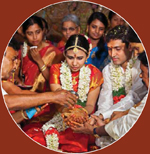 A central part of every Hindu’s life, samskaras are sacred rites of passage, such as coming of age and marriage, and childhood rites, including name-giving, first feeding, ear-piercing and head-shaving. They are held in temples, homes or halls. You may observe samskaras in progress during your visit. Consult with the temple priest for more information. These rites usually include a puja and a homa, or fire ceremony. If you request a samskara, the priest will set an auspicious time, explain how to prepare, what to bring, and what to do during the ceremony. §
A central part of every Hindu’s life, samskaras are sacred rites of passage, such as coming of age and marriage, and childhood rites, including name-giving, first feeding, ear-piercing and head-shaving. They are held in temples, homes or halls. You may observe samskaras in progress during your visit. Consult with the temple priest for more information. These rites usually include a puja and a homa, or fire ceremony. If you request a samskara, the priest will set an auspicious time, explain how to prepare, what to bring, and what to do during the ceremony. §
Fire Rites§
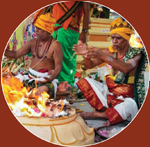 Major pujas in temples are often preceded by a homa, or “fire-offering,” among the most ancient forms of Hindu worship. Fire is the object of worship, and oblations are offered into a sanctified fire pit, which is usually made of earthen bricks. One or more priests sit near and tend the fire, offering wood, ghee, grains and dried herbs while chanting mantras from the Vedas and Agamas. The rites invoke the temple’s main Deity as well as other Gods, such as Ganesha, Agni and Varuna. §
Major pujas in temples are often preceded by a homa, or “fire-offering,” among the most ancient forms of Hindu worship. Fire is the object of worship, and oblations are offered into a sanctified fire pit, which is usually made of earthen bricks. One or more priests sit near and tend the fire, offering wood, ghee, grains and dried herbs while chanting mantras from the Vedas and Agamas. The rites invoke the temple’s main Deity as well as other Gods, such as Ganesha, Agni and Varuna. §
Did You Know? §
In a Hindu temple there is often a multiplicity of simultaneous proceedings and ceremonies. In one corner, an extended family, or clan, with its hundreds of tightly knit members, may be joyously celebrating a wedding. At another shrine a lady might be crying in front of the Deity, saddened by some misfortune and in need of solace. Elsewhere in the crowded precincts, a baby is being blessed, and several groups of temple musicians are filling the chamber with the shrill sounds of the nagasvaram and drum. After the puja reaches its zenith, brahmin priests move in and out of the sanctum, passing camphor and sacred ash and holy water to hundreds of worshipers crowding eagerly to get a glimpse of the Deity. All of this is happening at once, unplanned and yet totally organized. It is a wonderful experience, and such a diverse array of devotional ceremonies and such an intensity of worship can only be seen in a Hindu temple. There is no place on Earth quite like a Hindu temple.Ӥ
Living with Siva§
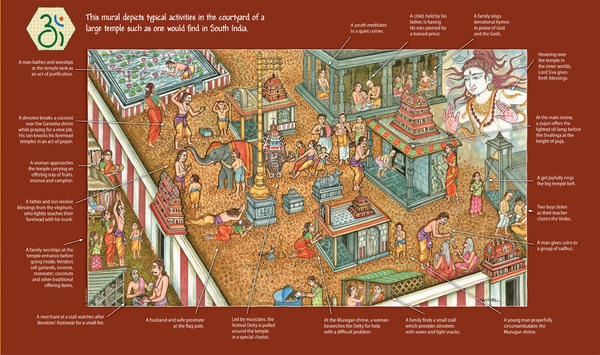
 Questions & Answers§
Questions & Answers§
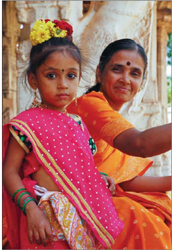
Spiritual culture: A mother and daughter attend the temple together; devotees draw blessing from the arati flame after puja at a temple in Mumbai; a girl prays at a puja in Ubud, Bali
• • • • • • • • • • • • • •§
What is the cosmology that gives rise to the belief in Gods and devas?§
Satguru Sivaya Subramuniyaswami: Hinduism views existence as composed of three worlds. The First World is the physical universe, the Second World is the subtle astral or mental plane of existence in which the devas, or angels, and spirits live, and the Third World is the spiritual sphere of the Mahadevas, the Deities, the Gods. Hinduism is the harmonious working together of these three worlds. Religion blossoms for the Hindu as he awakens to the existence of the Second and Third Worlds. These inner worlds naturally inspire in man responses of love and devotion and even awe. They are that wonderful. §
What is the significance of the temple?§
BAPS Swaminarayan Sanstha: Mandir is the Hindu name for a place of worship or prayer. Mandir is a Sanskrit word meaning the place where the mind becomes still and the soul floats freely to seek the source of life, peace, joy and comfort. For centuries, the mandir has remained a center of life, a common community place where people forget their differences and voluntarily unite to serve society.§
Sivaya Subramuniyaswami: On this Earth plane the Gods have a special home, and that is the holy temple. It is in the sanctified temple, where regular and proper puja is being performed in a pure way, that the Gods most easily manifest. You can go to a Hindu temple with your mind filled up with worries, you can be in a state of jealousy and anger, and leave the temple wondering what you were disturbed about, completely free from the mental burdens and feeling secure. So great are the divine psychiatrists, the Gods of our religion, who live in the Third World, who come from the Third World to this world where our priests perform the pujas and invoke their presence over the stone image. §
Why are temples needed? §
BAPS: Every religion in its own tradition builds houses of worship. It is the mandir that fuels our faith in God, strengthens our society and teaches us to trust one another and to become trustworthy. Schools will educate the mind, but who will educate the soul? Hospitals will mend a broken arm, but who will mend a broken heart? Cinemas and arcades will excite the mind, but where will one go for peace of mind? The mandir is a center for learning about man, nature and God. It is where ethics and values are reinforced. It is where people celebrate festivals and seek shelter in sad times. It is where talents in various arts—music, literature and sculpture—are offered in the service of God.§
Are there varied views regarding the Gods and temple images, or murtis?§
Yes, from the Agamic perspective, the murti is considered a sacred medium of the Divine. Another view is that the various murtis are symbols of the facets of Divinity. §
Acharya Ananda Swami, Pitampura Temple, West Delhi: The sanctum sanctorum is the place where God resides. In Hindu culture, the idol is made based on the form of God which our rishis and saints saw through their penance and meditation. So, for us the idol is not just something made of stone; it is a form of God, a living God. These idols are established in the temples following directions given in our Shastras and Vedas. Once the idol is established with due rituals, that place becomes the garbhagriha, or sanctum sanctorum. To maintain the purity of the temple, only the priest can enter the sanctum or touch the Deity.§
Chinmaya Mission: God, the infinite, the formless, is exceedingly hard to contemplate upon. Most of us need some grosser expression. Symbols of the eternal principle are called idols, murtis. These idols represent the eternal principle, God, the ideal.… If we are not yet able to see the Lord in everything, we are asked to first practice seeing him in at least one image and then slowly expand our vision (Bal Vihar Teacher’s Handbook, Grade Five).§
BAPS: Sanatan Dharma believes in murti puja—worshiping Bhagwan, His avatars and Deities in the form of images. Followers believe in the presence of the Divine in such images and offer them worship with faith (shraddha) and loving devotion (bhakti). In turn, due to His grace, the Divine accepts this bhakti. Throughout Sanatan Dharma’s history, He has let His manifestations and Divinity be known through various murtis and [miraculous] events.§
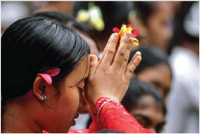 Is Temple Worship Only for Beginners?§
Is Temple Worship Only for Beginners?§
Temple worship is for all men and women at every level of spiritual development. Its meaning and experience deepen as we unfold spiritually through the stages of service, devotion, yoga and enlightened wisdom.§
Dancing with Siva§
How should one prepare to go to the temple?§
Acharya Ananda Swami: Devotees should come with complete mental and physical purity. In the temple the devotees should engage in bhajan, kirtan and worship of God. Before we enter the temple, we must purify ourselves by sprinkling of water and also purify our inner self by chanting holy mantras. Even our dress should be sattvic and light colored or even white. We must wear fresh clothes and avoid wearing leather items, like belts and shoes. Our heart should have sattvic feelings when we come to the temple. §
Why have many temples in the Hindu diaspora combined the functions of temple and satsang hall in one facility? §
Pandit Roopnauth Sharma, Ram Mandir, Toronto: When people move from an environment they are accustomed to, they try to accommodate situations and in so doing may create a new approach to getting something done. When people settled in the colonial countries, they were given accommodations in simple lodges, and there was only one gathering hall. They placed the Deity there, did their puja there and congregated there for satsang. They held their havan there as well. But in India that would not happen. In the Caribbean it became a place for darshan and shiksha (teaching) and satsang because it was the only place they had, and this is what is evolving in North America today—like our congregation here in Ram Mandir. We are trying to create an environment where people come and sit and listen and learn, an institution not only for darshan but for spiritual learning, and learning about the Hindu way of life.§
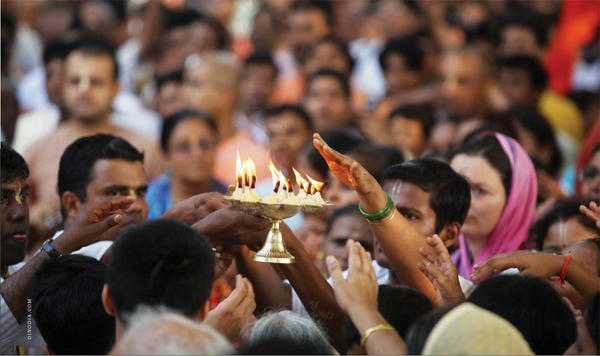
Padmaja Patel, Midland, Texas: In North America, in addition to temples of traditional South Indian style, there are many community temples which include a satsang hall and murtis. Our local temple falls in that category. To best utilize the space and money, we also have a stage in the hall for children’s cultural performances. The current design serves our small community well. The other important factor is that some of the smaller communities cannot afford to have a full-time priest, so this type of non-traditional temple serves them well.§
Acharya Ananda Swami: In North India there are also many temples where the design is such that the idols are placed inside a satsang hall.§
What is the purpose of walking around the temple or shrine?§
Acharya Ananda Swami: There is a special importance of pradakshina (or parikrama). For different Gods and Goddesses there are different numbers of pradakshina one has to undergo. Most knowledgeable devotees undertake pradakshina as part of their routine of worship. The devotee can do general pradakshina for all the Gods, once, thrice, eleven, twenty-one, fifty-one times or even more. §
Sivaya Subramuniyaswami: When we come to the temple out of the world, off the street, we are often shrouded by negative vibrations, which can actually be seen in our aura. Our nerve system may be upset, especially now, in the technological age, when we often suffer from stress and strain, the insecurity of so many changes and the rapid pace of life. In order to prepare ourselves to enter the sanctum sanctorum of the temple, the great mandapam inside, we walk clockwise around the temple very slowly. In this way we prepare our mind. We consciously drop off worldliness, letting the sufferings go, letting all disturbances leave our mind the best we can, and trying to reach deep inside of ourselves where peace exists eternally. We become as celestial as we can during the time we are walking around the temple, so that we can communicate with the celestial beings within the temple. §
How does the temple help individuals?§
BAPS: A hectic routine packed with work tensions and idealistic ambitions, imperfect relationships and demanding family stresses, leaves the average individual with an ardent craving for answers to life’s unlimited questions; the most burning being: “How can I attain peace of mind?” Sometimes the individual may turn to alcohol, substance abuse, crime, gambling or other such vices, helplessly in search of peace. Many genuine efforts are also made, such as recreational activities, days off or retreats. The mandir offers a refreshing tranquility. Through its natural teachings and activities of prayer and worship, the mandir generates devout faith in God and in fellow man and guides the individual towards spirituality. With this new-found faith in God, the individual embraces physical, mental, and spiritual purity. The teachings and natural activities of the mandir offer the individual an understanding that peace of mind does not lie in addictions and other such vices. They mold the character of the individual by endowing basic virtues of humanity such as fidelity, courage, forgiveness, unity, friendship, honesty, humility, tolerance, understanding, patience, charity and universal brotherhood. Thus, the mandir also plays an indirect role in improving society by improving the state of the individual.§
What is the significance of the showing of lights?§
BAPS: Only through the light of knowledge can one welcome Bhagwan in one’s heart. The symbol of this knowledge is light. Only in the light can one have Bhagwan’s darshan. Arati is the ritual that welcomes Bhagwan with light.§
Acharya Ananda Swami: Fire worship has a significant role in the temple. It is used in the puja and archana. We light the dipas and perform the arati in which the role of fire is very important. When special festivals or functions are held, dipas or lamps are lit ’round the clock. §
What cultural importance does the mandir have?§
BAPS: Throughout the history of Hindu civilization, mandirs have been the most significant patrons of architecture, sculpture and painting. Mandirs were also great patrons of the performing arts, supporting the performance and teaching of devotional vocal and instrumental music. Mandirs also promoted a tradition of devotional dance. These traditions of music and dance were developed in the mandir and spread out into the wider culture. Without the mandir’s patronage, these priceless artistic traditions would not be available for the world to appreciate today.§
 Ten Tips to Make the Most of Your Visit§
Ten Tips to Make the Most of Your Visit§
 Attend a puja at the temple at least once a week. Experienceing the divine energy of God and the Gods on a regular basis helps keep you pure and strong in your religious commitments.§
Attend a puja at the temple at least once a week. Experienceing the divine energy of God and the Gods on a regular basis helps keep you pure and strong in your religious commitments.§
 Dress in traditional Hindu clothing. This helps put you in a religious mood. Keep special clothing just for the temple. §
Dress in traditional Hindu clothing. This helps put you in a religious mood. Keep special clothing just for the temple. §
 Make your travel to the temple a religious time. This prepares you to arrive in a spiritual frame of mind. Don’t focus on problems or projects at home, work or school. Don’t think or talk about politics or business. Listen to religious music or chanting while in transit. Tell the children uplifting stories.§
Make your travel to the temple a religious time. This prepares you to arrive in a spiritual frame of mind. Don’t focus on problems or projects at home, work or school. Don’t think or talk about politics or business. Listen to religious music or chanting while in transit. Tell the children uplifting stories.§
 Bring an offering. Ideally, bring a flower, flower garland or fruit for each shrine at which you worship. The act of giving makes you receptive to blessings.§
Bring an offering. Ideally, bring a flower, flower garland or fruit for each shrine at which you worship. The act of giving makes you receptive to blessings.§
 Put prana into what you offer. Prana is the energy that exudes from your hands. Buying a garland is good, but making one is even better. When the priest puts your hand-made garland on the murti, it’s almost like you are touching the Deity yourself.§
Put prana into what you offer. Prana is the energy that exudes from your hands. Buying a garland is good, but making one is even better. When the priest puts your hand-made garland on the murti, it’s almost like you are touching the Deity yourself.§
 Focus on the worship service and the priest’s chanting. Don’t let the mind wander. Learn, at least generally, the meaning of what the priest is chanting. Similarly, when singing bhajans, keep focused on the meaning of the song. §
Focus on the worship service and the priest’s chanting. Don’t let the mind wander. Learn, at least generally, the meaning of what the priest is chanting. Similarly, when singing bhajans, keep focused on the meaning of the song. §
 Stay for a while after the ceremony. Don’t rush away. Sit and meditate. Bask in the divine energy of the temple. This is also an ideal opportunity for japa.§
Stay for a while after the ceremony. Don’t rush away. Sit and meditate. Bask in the divine energy of the temple. This is also an ideal opportunity for japa.§
 Light an oil lamp in your shrine room when you get home. This brings devas who were at the temple right into your sacred space. From the inner world, they will bless the family and strengthen the spiritual force field of the home. §
Light an oil lamp in your shrine room when you get home. This brings devas who were at the temple right into your sacred space. From the inner world, they will bless the family and strengthen the spiritual force field of the home. §
 Watch for auspicious days. The Deity’s presence is stronger on some days than others. By attending the temple on the most auspicious days, you become attuned to the Deity’s blessings. For example, blessings are especially strong during the annual festival days.§
Watch for auspicious days. The Deity’s presence is stronger on some days than others. By attending the temple on the most auspicious days, you become attuned to the Deity’s blessings. For example, blessings are especially strong during the annual festival days.§
 Gain strength by taking vows. It is common to take a vow, or vrata, during festivals. A typical vrata is to fast during a day of temple ceremonies and break the fast that evening. §
Gain strength by taking vows. It is common to take a vow, or vrata, during festivals. A typical vrata is to fast during a day of temple ceremonies and break the fast that evening. §
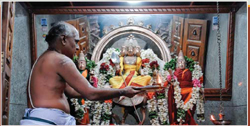
A priest passes an arati lamp before a Shanmukha Deity.§
How Do Our Prayers Reach the Gods?§
Through temple worship, the three worlds become open to one another, and the beings within them are able to communicate. By means of the mystical arts of puja, the worlds act in concert, and prayers are received. Aum.§
Dancing with Siva§